Director’s foreword
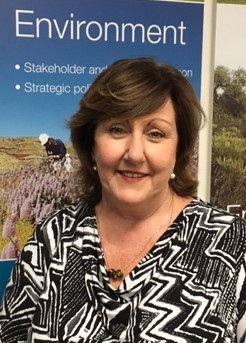
Welcome to the third edition of the Environment eNewsletter for 2017.
The new Department of Mines, Industry Regulation and Safety’s (DMIRS) was formed on 1 July 2017. The Premier of Western Australia announced the first round of Machinery of Government (MOG) changes in April 2017, which have affected a wide range of State Government departments and other agencies in the WA public sector. DMIRS is an amalgamation of the former Department of Mines and Petroleum and parts of the Department of Commerce. DMIRS business units are clustered into three new Groups – Resources, Titles and Compliance (RT&C), Industry Regulation and Consumer Protection (IRCP) and Safety. Environment is part of RT&C.
DMIRS also welcomes David Smith as its new Director General. Mr Smith was the former acting Director General of the Department of the Premier and Cabinet. He has more than 20 years of experience in the Commonwealth public service, including the Department of the Prime Minister and Cabinet and an overseas posting with the Department of Foreign Affairs and Trade. He has also worked with a private economic consultancy in London.
While the department has been changing, it has been business as usual for the Environment Division, with the Abandoned Mines Team set to commence its next two pilot projects at Bulong and Elverdton, having effectively closed the first two of the pilot projects. The team is also assisting the department to invite organisations to express interest in becoming the next tenement holder of Ellendale Diamond Mine, world renowned for it’s yellow diamonds.
Finally, we are once again busily preparing for the upcoming ‘2017 Golden Gecko Awards for Environmental Excellence’. Check out the story to see who’s been nominated and to purchase your tickets. I hope to see you at this prestigious event which aims to promote outstanding environmental excellence in the resources sector as part of the department’s Awards for Excellence.
Ms Karen Caple
Acting Executive Director Environment
2017 Golden Gecko Awards – tickets available now!
The assessment process for the 2017 Golden Gecko Awards for Environmental Excellence is almost complete with five entrants vying for the prestigious award. The Golden Gecko Awards celebrate innovation and leadership in environmental management in the mining and petroleum industries. The entries this year vary from exploration to rehabilitation projects.
The assessment is undertaken by a panel comprising representatives from the Departments of Mines, Industry Regulation and Safety (DMIRS), Biodiversity Conservation and Attractions, Water and Environmental Regulation, Jobs, Tourism, Science and Innovation; and Primary Industries and Regional Development. The panel’s expertise is then used by the Golden Gecko Selection Committee to decide the winner(s).
The awards are based on four criteria – commitment to environmental excellence, demonstrated excellent environmental outcomes, community engagement and innovation.
The five entrants and their projects eligible for the 2017 Golden Gecko Awards are:
- Hanson Construction Materials and Kings Park and Botanic Gardens
Banksia Woodlands – A Restoration Guide for the Swan Coastal Plain
- Rio Tinto Iron Ore
Protecting our Northern Quolls from Introduced Predators
- Rio Tinto Iron Ore
Venturi Reverse Circulation Drilling Waste Removal System
- Roy Hill Holdings
Utilising Mining Technology for the Tracking and Management of Rehabilitation Materials
- Sinosteel Midwest Corporation and the Botanic Garden and Parks Authority
Leading Practice in Banded Iron Formation Restoration
The Golden Gecko Awards will be presented at DMIRS’ annual Awards for Excellence night on Thursday 26 October 2017. This years awards will be held at the Parmelia Hilton and open with a free seminar by the entrants to showcase their projects. The awards ceremony will be followed by a cocktail style reception.
Tickets for the ceremony, which includes the cocktail function, are $60 and available online until Thursday 19 October 2017. The ceremony will also include the Community Partnership Awards and the Safety and Health Resources Sector Awards.
Tickets are limited !!
|
Awards Night: |
Thursday 26 October 2017 |
|
Order of Proceedings: |
Pre-Award Seminar:
2.00pm 2.30pm - 5.00pm
5.00pm 6.00pm |
|
Location: |
Pamelia Hilton Hotel |
|
Ticket Cost: |
$60 |
|
How to pay: |
Visit eventbrite.com.au |
|
Bookings close: |
Thursday 19 October 2017 |
|
Further information: |
Website: GoldenGeckoAwards |
Call for submissions on small mining operations form
The Department of Mines, Industry Regulation and Safety (DMIRS) is seeking industry feedback on the draft Low Impact Mining Operations (LIMO) form.
In consultation with key stakeholders, DMIRS is undertaking a revision of the current environmental approval forms submitted for small (low impact) mining operations.
DMIRS is proposing to replace the existing ‘Mining Proposal for Small Operations’ and ‘Mine Closure Plan for Small Operations’ forms with a single combined form that aligns with the ‘Guideline for Mining Proposals in Western Australia 2016’.
The draft form also includes proposed changes to the criteria for a small mining operation, recognising the level of operational risk and environmental outcomes. It is intended that the form be available to all small mining operations across Western Australia.
Three targeted workshops have been held in Kalgoorlie since March 2017, to discuss these changes with stakeholders. The workshop attendees have provided valuable input into the draft, allowing DMIRS to incorporate industry feedback at an early stage in the revision process.
The draft form is available through the DMIRS website for an eight-week public feedback period, which commenced Wednesday 13 September. Stakeholder submissions close on Wednesday 8 November 2017. If you would like to provide feedback on the draft form please email your comments to MPReformEnquiry@dmirs.wa.gov.au.
Call for submissions on guidance for risk assessments and environmental outcomes
The Department of Mines, Industry Regulation and Safety (DMIRS) ran a series of workshops in February and March to assist industry with the Guideline for Mining Proposals in Western Australia - April 2016. DMIRS is pleased with the success of the workshops which provided examples of risk assessments and environmental outcomes, and enabled tangible examples to be discussed and assessed amongst groups of industry professionals and DMIRS Environmental Officers.
DMIRS has drafted some additional guidance for risk assessments and environmental outcomes based on the results of the workshops and feedback from the first assessments. The guidance is not intended to set specific requirements but instead provides additional guidance on undertaking environmental risk assessments and in developing appropriate environmental outcomes.
Stakeholder comments provide invaluable feedback to DMIRS and we encourage stakeholders to read the draft guidance and to submit comments to the department.
The draft guidance is available through the Consultation page for an eight-week public feedback period, which commenced 14 September. Stakeholder submissions close on Thursday 9 November 2017, so if you would like to provide feedback on the draft guidance please use the feedback form provided above.
For more information about the public consultation process or the draft risk assessments and environmental outcomes guidance documents, please email MPReformEnquiry@dmirs.wa.gov.au
Drone trial
The Department of Mines, Industry Regulation and Safety (DMIRS) has begun a six month trial to determine if remotely piloted aircraft (RPA) technology can be incorporated into the department’s daily business.
Many Australian government agencies are embracing the RPA technology which lends itself to meeting the challenges and expectations that come with operating in an increasingly complex environment.
Eight DMIRS officers have completed Remotely Piloted License (RePL) and Civil Aviation Safety Authority (CASA) approved training to be able to fly the drone during a pilot trial period. Three officers from Environment were included in the training and will be trialling the drones throughout the pilot, which will include site inspections where appropriate, investigating exploration activities and abandoned mines.
DMIRS’ licensed operators will be flying the drone in line with the department’s operating procedures which have been developed in consultation with other government agencies, including the Department of Transport, the Department of Biodiversity, Conservation and Attractions, and leading energy companies BHP and Woodside.
DMIRS believes that RPA technology will help improve processes, make operations safer for staff and improve situational awareness. Before purchasing the drone earlier this year, DMIRS established a project team to assess the risks, opportunities and potential cost advantages. Following thorough research and analysis, the group concluded that it is an opportune time to implement the technology, particularly given recent changes in legislation which have made it cheaper and easier to commercially operate RPAs.
For more information about the drone trial, please contact Clare Grosser on (08) 9222 3436.
Programme of Work spatial lodgement update
Industry training sessions for a new spatial lodgement system for Programme of Work (PoW) applications have been rolled out by the Department of Mines, Industry Regulation and Safety (DMIRS).
DMIRS has had an overwhelming response to the industry training sessions and have released new dates for November in Perth and Kalgoorlie. There are 15 spaces available per training session and the training is free but attendees must register as space is limited.
| Perth | Kalgoorlie |
|
Wednesday 1 November |
Thursday 2 November |
The new system offers real time feedback based on the activities described by the applicant, giving the applicant relevant information on the described activities at the lodgement stage. The system will prompt the applicant for information during the lodgement process, ensuring adequate information is provided in the application and reducing the likelihood of questions during the assessment process.
The new system will soon become mandatory for exploration activities, however, Programme of Work prospecting (POW-P) forms will continue to be accepted in hard copy or online through POW-Spatial or DMIRS Submissions.
The updated map-based application allows users to enter their proposed activities, either by loading existing spatial files or creating spatial files on screen. The system conducts automatic checks by intersecting the proposed activities with other data layers of environmental and cultural significance, alerts the user with the results and also provides suggestions for additional actions required to support the application.
The new system has many benefits including providing real time feedback before the submission and allows users to draw, or upload, shape files. It provides all the relevant information on the tenement at lodgement stage rather than the assessment stage. This will mean a much faster process for all involved.
To register for a training session please email PoWSpatial@dmirs.wa.gov.au.
Stakeholder Engagement Tool
It is imperative that with every project undertaken at the Department of Mines, Industry Regulation and Safety (DMIRS), stakeholders are identified and frequently consulted. There are several tools to identify stakeholders, however, the complexity in using these tools makes it difficult to determine a comprehensive list of relative stakeholders for each project.
Environment's Abandoned Mines Program (AMP) team developed a Stakeholder Identification Tool to assist in developing necessary strategies for identifying relevant stakeholders and to allow appropriate consultation. The tool offers the benefit of utilising simple features that produce a highly detailed map of identified stakeholders.
The Stakeholder Identification Tool's strong previous success in mapping relevant stakeholders has been noted in the AMP Black Diamond and Pro-Force rehabilitation projects. It will continue to be used by DMIRS and has now been made publicly available.
To ensure transparency and simplicity for public users, the 'Stakeholder Identification Tool' is accompanied by the 'Stakeholder Identification Tool User Guide'.
Stakeholder engagement is important, as identifying all relevant stakeholders allows for engagement plans to be developed and included in the overall operation of projects.
Supportive response to revised EP Summary submission process
The survey results for the Department of Mines, Industry Regulation and Safety’s (DMIRS) revised Environment Plan (EP) Summary submission process are now available online following a supportive response from stakeholders.
The department implemented a revised process in March 2016 requiring operators to submit the EP Summary document at the same time as the EP Lodgement and all relevant stakeholders were invited to provide feedback about the change in November 2016.
The current process will remain in place given the positive responses received from stakeholders.
This change to the submission process was made to enable the public to view information regarding petroleum and geothermal activities prior to activity approval, which aligns with the department’s transparency policy.
We received 15 elements of feedback from 19 stakeholder responses during the public feedback period and overall they were supportive of the changes. We would like to thank all the participants for providing their feedback and comments.
DMIRS is committed to ensuring that regulatory decision making and investment attraction processes, together with the technical information and data supporting them, are publicly available for the benefit of the Western Australian community.
The current EP Summary Submission Process flowchart is available on the DMIRS website. A report outlining the feedback received and responses to comments is also available on the DMIRS website.
DMIRS expert delivers guest lecture at Murdoch University
One of the Environment Division's leading experts in the regulation of mine site rehabilitation and environmental management, Dr Danielle Risbey, was invited to deliver a guest lecture in June at Murdoch University. Dr Risbey presented to 20 third year environmental students on mine site rehabilitation from a regulator’s perspective and shared some of the challenges mine operators encounter in their efforts to achieve successful rehabilitation outcomes.
Dr Risbey has been with the department more than 15 years and manages a team of environmental officers who assess proposals and mine closure plans and undertake environmental compliance inspections of mines in the northern half of Western Australia.
Dr Risbey described four key mine closure objectives that mining companies need to achieve, which include the rehabilitated mine is a safe, stable, non-polluting and self-sustaining post-mining landscape. It was highlighted that industry is expected to design for closure through robust, risk and evidence based decision making that is informed by effective stakeholder engagement. The presentation illustrated examples of mine sites operating in challenging environments and presented real life scenarios that the students were unlikely to have learnt from text books or lectures.
Dr Risbey felt she was able to give the students an appreciation of the planning and implementation processes involved, while broadening their understanding of the challenges associated with mine rehabilitation and that successful mine closure is a whole of mine-life process.
Exploration applications on the rise
The second quarter (June quarter) approval performance report showed the Department of Mines, Industry Regulation and Safety (DMIRS) again surpassed approvals targets, with a record 97 per cent of all applications finalised within target timelines.
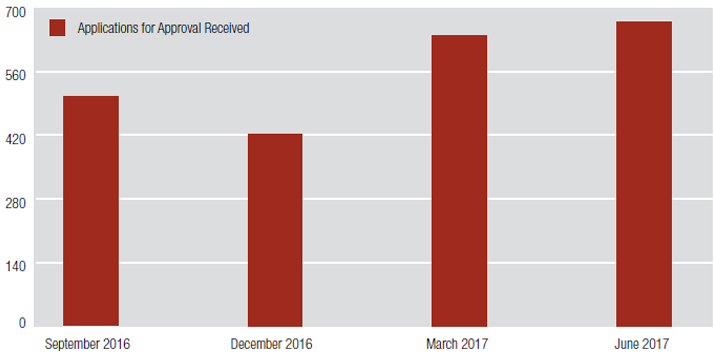
Number of mineral exploration Programme of Work applications received during 2016–17 financial year
There has been a significant increase in exploration applications. Mineral exploration applications surged during the first half of 2017, with a 40 per cent increase in the number of applications received compared to the second half of 2016.
The surge can be attributed to increased gold exploration in the Goldfields region. The breakdown of the number of mineral exploration (Programme of Work) applications received per quarter is:
- September 2016 - 502
- December 2016 - 421
- March 2017 - 640
- June 2017 - 669
The department’s performance has far surpassed its objective to finalise more than 80 per cent of all applications within target timelines. Target timelines vary according to the type of application. For example, the target time to finalise a Mining Proposal application is 30 business days. The target for a petroleum well application is 40 business days.
Abandoned Mines Program update
The Department of Mines, Industry Regulation and Safety’s (DMIRS) Abandoned Mines Program has completed rehabilitation works at Black Diamond Pit Lake (Black Diamond) and the Pro-Force Plant Site (Pro-Force); the first of its two pilot projects. The abandoned Ellendale Diamond Mine (Ellendale) also continues to be monitored to appropriately manage all significant safety and environmental risks as well as to preserve the remaining assets.
The Abandoned Mines Program is now commencing the remaining two pilot projects, Bulong and Elverdton, in the second half of 2017. The program will continue to build on the success of the recently completed pilot projects and will provide further updates through the Abandoned Mines webpage.
LeaP workshop to promote abandoned mine site rehabilitation
A forum was recently hosted by DMIRS in Perth for a group of Australian government officials to workshop new ways to prioritise abandoned mine site rehabilitation.
The Leading Practice (LeaP) group, established under COAG Energy Council’s Land Access for Resources Working Group, promotes intergovernmental cooperation in the practices and process relating to the management of abandoned mines across Australia. The group is investigating the development of a national code of practice for managing abandoned mines.
As part of the workshop, the LeaP delegation visited the first of the four pilot sites to be rehabilitated as part of the DMIRS Abandoned Mines Program, Black Diamond. DMIRS gave the interstate delegates an overview of the project, including some of the challenges faced, the successes and lessons learned.
The delegates also visited Iluka Resources’ Yoganup, Yoganup West and Cloverdale sites as further examples of successful mine site closure and rehabilitation. DMIRS thanks Iluka Resources for hosting the delegates.
Abandoned Mines Program - Projects
Ellendale Diamond Mine
DMIRS is currently preparing to invite organisations to express their interest in becoming the next tenement holder at the Ellendale Diamond Mine.

Ellendale, renowned for its yellow diamonds, is located approximately 120km east of Derby in the West Kimberley region of Western Australia. Ellendale’s largest tailings storage facility (TSF) covers an area of more than 2.5 square kilometres and was operational when the site was abandoned. Given the nature of the Kimberley’s wet season and the construction material of the TSF’s walls (red pindan soils or tailings), DMIRS is regularly monitoring the TSF. Remediation works were undertaken by DMIRS in December 2016 and January 2017 which significantly reduced the impact the 2016-17 wet season has had on the TSF. The remediation work involved the removal of an internal wall to reduce the likelihood of the facility overtopping, as well as the construction of 45 rock beds and 19 catchment baffles using rock from a nearby quarry.
DMIRS is taking all reasonable steps to ensure the remaining assets of Ellendale are managed to support and encourage the re-commencement of mining. Further monitoring of the facility is expected to occur before the 2017-18 wet season. More background and history regarding Ellendale can be found through the Abandoned Mines webpage.
Black Diamond Pit Lake Pilot
Following relevant stakeholder approval of a DMIRS Revegetation Plan for Black Diamond, the Abandoned Mines Program undertook a process to call for interest from local contractors and suppliers, for the revegetation of Black Diamond.
Oswald Environmental Solutions were engaged to undertake weed control and plant seedlings. DMIRS also partnered with erosion control experts, Dura-Veg and mine site rehabilitation specialists, WA Hydromulch, to apply a flexible growth medium to the remediated areas. Using an innovative and environmentally friendly product, the process will reduce soil erosion and provide favourable conditions to promote the germination of seed.
In addition, DMIRS worked closely with the Allanson Primary School to hold a seedling planting day to help promote the local communities connection to the site.
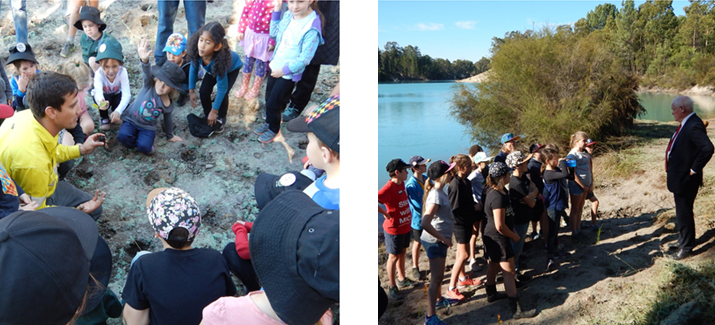
Allanson Primary School students take part in revegation at Black Diamond
In summary, revegetation works involved the distribution of approximately four kilograms of native seed, planting of 5000 sedges, 600 shrubs and trees, as well as weed control and the spreading of mulch.
DMIRS will undertake a monitoring program of the revegetation works, however the completion of revegetation essentially marks the project’s successful completion. The department sincerely thanks all stakeholders for their cooperation and input during the project.
The historical abandoned Black Diamond Pit Lake is located off Ferguson Road within the Allanson town site in the Shire of Collie, in the South West of Western Australia. More background and history regarding Black Diamond can be found on the Abandoned Mines webpage.
Pro-Force Plant Site
In consultation with the Shire of Coolgardie, DMIRS has developed a revegetation strategy for the Pro-Force site focusing on revegetation at the Gorge recreation area. The Shire will assume responsibility for completion of revegetation and the monitoring and maintenance of the area.
The revegetation area will have no impact on existing mining tenure. The revegetation around the access road to the water reserve will provide shade and improve the visual amenity of the area.
Rehabilitation activities undertaken at the Pro-Force site have been successful in removing the immediate public safety risks associated with abandoned processing infrastructure, old tyres, scrap metal and rubbish.
DMIRS has now completed its involvement in the Pro-Force project having achieved all objectives. The department sincerely thanks the Shire of Coolgardie and the local community for their cooperation and input during the project.
The Pro-Force Plant Site is approximately two kilometres southeast of Coolgardie and is adjacent to a public use area and ‘the Gorge’ water reserve which is regularly visited by locals and tourists. More background and history regarding the rehabilitation activities for the Pro-Force project can be found on the Abandoned Mines webpage.
More information
For further information on the Abandoned Mines Program:
Phone: +61 8 9222 3162.
Email: abandonedmines@dmirs.wa.gov.au
Web: Abandoned Mines webpage
Mining Rehabilitation Fund (MRF) update
MRF reporting
Thank you to all those who submitted their 2017 Mining Rehabilitation Fund (MRF) reports by 30 June 2017. Once again, assessment information was provided on time for more than 99 per cent of tenements. This is an excellent result, especially considering that there are now more tenement holders than last year.
Unfortunately, the higher number of tenement holders also meant that we issued more infringement notices for failing to lodge reports on time, compared to last year. The department issued notices to 127 individual tenement holders (covering 191 tenements), compared to 108 last year. While this is disappointing, it is still less than 1per cent of reports and many of the affected holders have since provided the information required.
The MRF Team is available to assist you if you have any questions, so please do not hesitate to contact them.
Email: mrfenquiry@dmirs.wa.gov.au
Phone: (08) 9222 3162
Please contact the department’s IT Service Desk, for any technical queries.
Phone: (08) 9222 0777
For more information about MRF reporting and how to lodge your report, please refer to the following documents located under ‘MRF documents’ on the MRF webpage:
- Mining Rehabilitation Fund – Guidance
- Mining Rehabilitation Fund – Verification Code Registration Step by Step Guide
- Mining Rehabilitation Fund – Frequently Asked Questions
Please remember that you can lodge your MRF information anytime between 1 July 2017 and 30 June 2018.
MRF annual audit program
DMIRS conducts an annual Audit Program to verify that all reported MRF disturbances are accurately reported. In addition to ensuring the department has accurate rehabilitation liability information, the validation of industry data also ensures the correct rehabilitation levies are being applied to mining tenements.
The selection of tenements to be audited is either random or based on risk. Tenements may be audited in consecutive years, depending on their level of risk. During the 2016/2017 financial year, DMIRS audited more than 4,000 tenements.
DMIRS wishes to acknowledge the cooperation of all tenement holders who have been audited to date, especially those who have provided timely responses to resolve discrepancies found during audits.
Public consultation
The Department of Mines, Industry Regulation and Safety (DMIRS) is committed to stakeholder engagement.
Effective and ongoing stakeholder engagement enables better planned and more informed policies, projects and services, including a greater understanding and management of issues and potential risks. For stakeholders, the benefits of engagement include the opportunity to have their issues heard and to contribute to the decision-making process.
Open for Public Consultation
Documents open for public consultation are located on the Consultation webpage.
|
Summary |
Date Closing |
Contact |
|
8 November 2017 |
Please submit your comments to: MPReformEnquiry@dmirs.wa.gov.au |
|
|
Draft Guidance Notes: |
9 November 2017 |
Please complete the feedback form and email to: MPReformEnquiry@dmirs.wa.gov.au |
Public consultation closed
By way of a summary, public consultation has now closed for the items listed below. Closed items will remain accessible on the Consultation webpage for a minimum period of 12 months.
|
Summary |
Date Closed |
|
Draft Partnership Guideline developed to support the department's Abandoned Mines Program. |
6 January 2017 |
|
Changes to Environment Plan Summary Submission Process – for stakeholder comment |
30 November 2016 |
|
Draft Guidance – Materials Characterisation Baseline Data Requirements for Mining Proposals |
29 April 2016 |
|
Draft Guideline for the Development of Petroleum and Geothermal Environment Plans in Western Australia |
15 April 2016 |
|
Draft Guideline for the Development of an Onshore Oil Spill Contingency Plan |
4 March 2016 |
|
Draft Guideline Groundwater Monitoring in the Onshore Petroleum and Geothermal Industry |
4 March 2016 |
|
Procedure for Declining and Refusing Environmental Applications - draft for public consultation |
31 January 2016 |
Compliance actions
The Department of Mines, Industry Regulation and Safety’s (DMIRS) Environment Division oversees an Environment Enforcement Panel that considers cases of alleged breaches of tenement conditions under the Mining Act 1978 and provides advice to the Minister for Mines and Petroleum on whether forfeiture, or a penalty in lieu of forfeiture, should be imposed.
DMIRS considers it important to raise industry’s awareness of common types of breaches that occur, with the aim of promoting the importance of compliance.
Penalties in lieu of forfeiture imposed by the Minister for Mines and Petroleum
This is a consolidated list of confirmed Mining Act 1978 breach of tenement conditions between 1 April and 30 June 2017 that have had a penalty imposed by the Minister for Mines and Petroleum.
|
Penalty |
Nature of Breach |
Learnings for Industry |
Detection By |
Minister’s Decision Date |
No. of Tenements |
Individual or Company |
|
$38,000 |
Infrastructure not constructed in accordance with the approved plans and additional infrastructure installed without approval; mining exceeding approved depths; mining areas were not battered, contoured, or rehabilitated. |
Ensure all approvals have been received before undertaking works; ensure any alterations or expansions have been approved; ensure there is an understanding for on-site approval processes within your organisation; ensure rehabilitation is safe, stable and non-polluting. |
Application for a mining proposal. |
19/6/2017 |
1 |
Company |
|
$31,000 |
Not conducting operations in accordance with Environmental Management Plans; not removing all topsoil ahead of mining; |
Ensure all approvals have been received before undertaking works; ensure any alterations or expansions have been approved; ensure there is an understanding for on-site approval processes within your organisation. |
Application for a mining proposal and inspection. |
21/6/2017 |
1 |
Shire |
|
$16,313 |
Exceeding permitted maximum area of disturbance, and not undertaking progressive rehabilitation. |
Ensure operations are undertaken in accordance with approvals. |
Application for a reconciliation mining proposal. |
25/6/2017 |
1 |
Company |
Approvals - Second Quarter 2017
1 April to 30 June 2017
|
Environment Minerals |
Environment Petroleum |
|
Mining Proposals |
Environment Plans |
|
View a list of Mineral Approvals by Mineral Field |
View a list of Petroleum Approvals by Region |
Approvals Performance Report
1 April to 30 June 2017
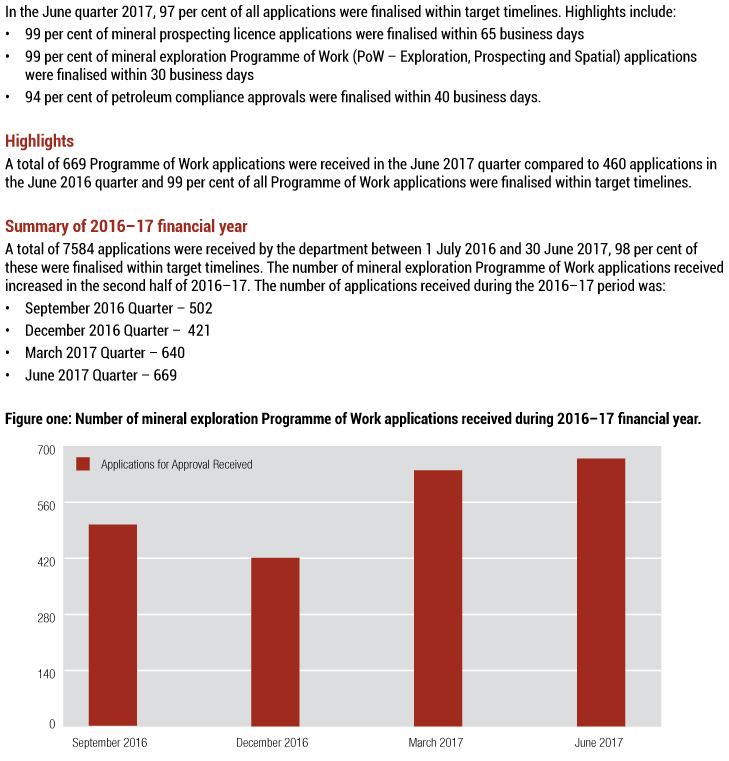
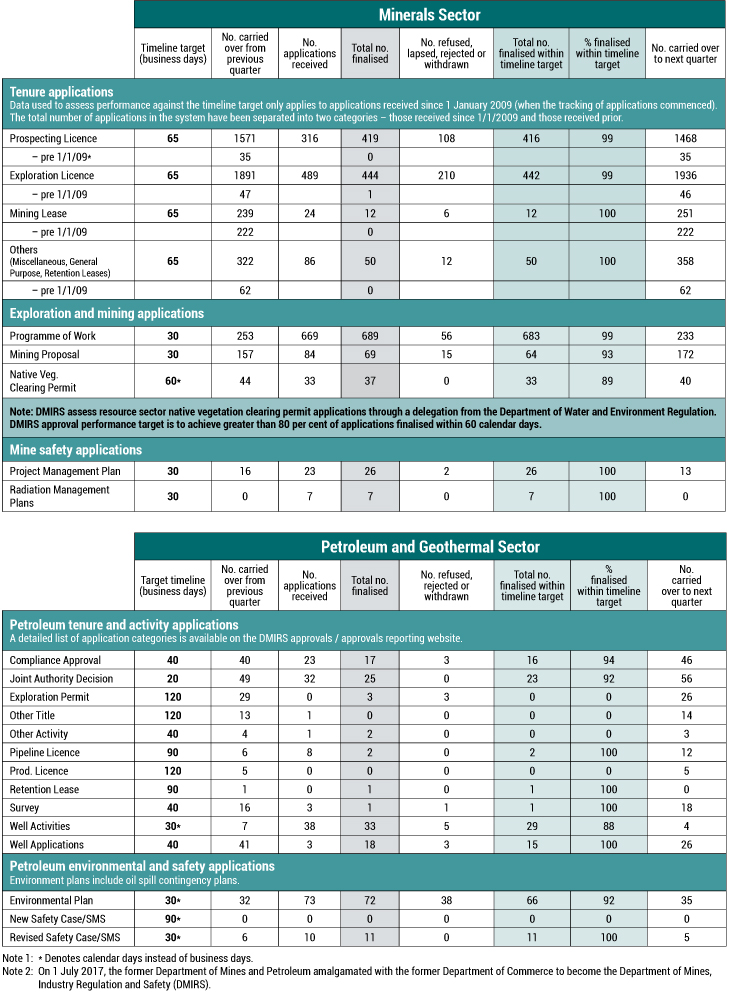
Contact details for Environment
Please keep these contact details handy for the Department of Mines, Industry Regulation and Safety’s (DMIRS) Environment Division.
Minerals assessment or compliance
The map linked provides you with the contact details of the DMIRS Environmental Officers responsible for your inspectorate/mineral field area.
Inspectorate map and responsible Environmental Officers
Petroleum environment operations
General enquires, notification of commencement or completion of a petroleum activity and notification of reportable environmental incident.
Email: petroleum.environment@dmirs.wa.gov.au
EARS / EARS 2 online system
General application and compliance reporting enquiries
Email: EARSManager@dmirs.wa.gov.au
Phone: (08) 9222 3535
Mining Rehabilitation Fund (MRF)
Mining Rehabilitation Fund enquiries
Email: mrfenquiry@dmirs.wa.gov.au
Phone: (08) 9222 3162
Golden Gecko Awards
Entry forms and details of how to enter the 2018 Golden Gecko Awards will be posted on the Golden Gecko webpage early in 2018.
For any further enquiries
Email: golden.gecko@dmirs.wa.gov.au
Phone: (08) 9222 3102
Programme of Work (PoW) spatial training
Registration and general enquiries
Email: PoWSpatial@dmirs.wa.gov.au
Mining Proposal (MP) Reform
Mining Proposal Reform enquiries
Email: mpreformenquiry@dmirs.wa.gov.au